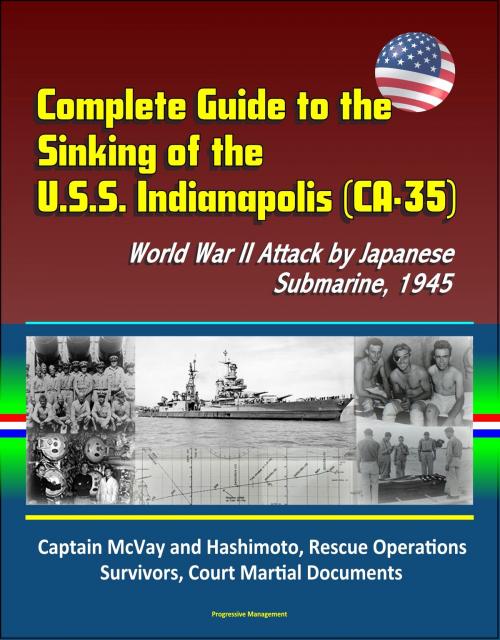Complete Guide to the Sinking of the U.S.S. Indianapolis (CA-35), World War II Attack by Japanese Submarine, 1945, Captain McVay and Hashimoto, Rescue Operations, Survivors, Court Martial Documents
Nonfiction, History, Military, Naval, World War II| Author: | Progressive Management | ISBN: | 9781370586967 |
| Publisher: | Progressive Management | Publication: | July 31, 2016 |
| Imprint: | Smashwords Edition | Language: | English |
| Author: | Progressive Management |
| ISBN: | 9781370586967 |
| Publisher: | Progressive Management |
| Publication: | July 31, 2016 |
| Imprint: | Smashwords Edition |
| Language: | English |
Professionally converted for accurate flowing-text e-book format reproduction, this unique book provides a complete account of the tragic sinking of the U.S.S. Indianapolis near the end of World War II. The warship, commanded by Captain Charles McVay, was attacked by a Japanese submarine commanded by Captain Mochitsura Hashimoto. The loss of USS Indianapolis (CA-35) in the first hour of 30 July 1945 left approximately 800 Sailors and Marines out of a crew of 1,196 adrift—most with only a life jacket or floater net. The rapid sinking of the ship, and critical damage to communication systems, prevented the sending of a distress signal. These circumstances, coupled with misunderstandings of protocol for reporting the non-arrivals of ships, delayed the rescue of Indianapolis survivors until 2-3 August. After four to five days spent in the water awaiting rescue, only 316 survived. Many of the casualties resulted from dehydration and overexposure.
Historians at the Naval History and Heritage Command have revisited archival records relating to the 30 July 1945 sinking of Indianapolis, the rescue operations, and the court martial of her captain, Charles B. McVay, III in an attempt to learn more about the tragedy and to make historical records of the sinking more readily available to the Navy community and the public. In the process of preparing the pages that follow, historians at NHHC have discovered new information regarding the location of Indianapolis along her route on her final day.
Document contents include: A. Routing and Sinking * B. Intelligence Pertaining to the Loss of USS Indianapolis * C. Rescue Operations * D. Lieutenant Commander Lewis Haynes, USN * E. Survivors of the U.S.S. Indianapolis * F. Investigation and Court Martial * G. Selected Bibliography
Professionally converted for accurate flowing-text e-book format reproduction, this unique book provides a complete account of the tragic sinking of the U.S.S. Indianapolis near the end of World War II. The warship, commanded by Captain Charles McVay, was attacked by a Japanese submarine commanded by Captain Mochitsura Hashimoto. The loss of USS Indianapolis (CA-35) in the first hour of 30 July 1945 left approximately 800 Sailors and Marines out of a crew of 1,196 adrift—most with only a life jacket or floater net. The rapid sinking of the ship, and critical damage to communication systems, prevented the sending of a distress signal. These circumstances, coupled with misunderstandings of protocol for reporting the non-arrivals of ships, delayed the rescue of Indianapolis survivors until 2-3 August. After four to five days spent in the water awaiting rescue, only 316 survived. Many of the casualties resulted from dehydration and overexposure.
Historians at the Naval History and Heritage Command have revisited archival records relating to the 30 July 1945 sinking of Indianapolis, the rescue operations, and the court martial of her captain, Charles B. McVay, III in an attempt to learn more about the tragedy and to make historical records of the sinking more readily available to the Navy community and the public. In the process of preparing the pages that follow, historians at NHHC have discovered new information regarding the location of Indianapolis along her route on her final day.
Document contents include: A. Routing and Sinking * B. Intelligence Pertaining to the Loss of USS Indianapolis * C. Rescue Operations * D. Lieutenant Commander Lewis Haynes, USN * E. Survivors of the U.S.S. Indianapolis * F. Investigation and Court Martial * G. Selected Bibliography















